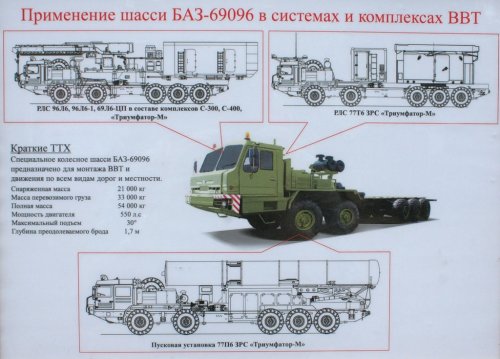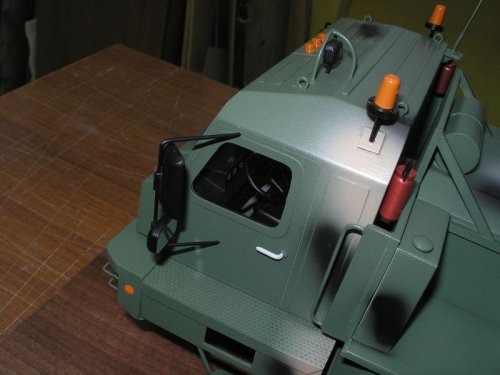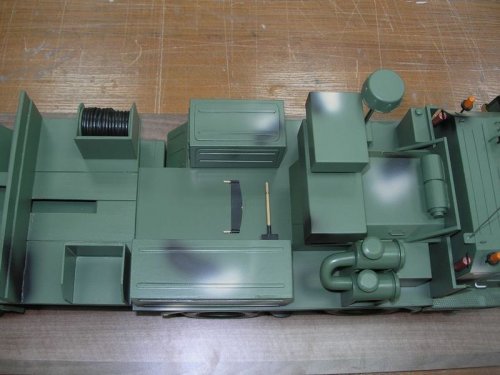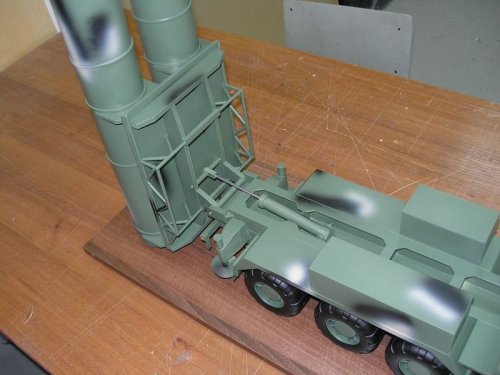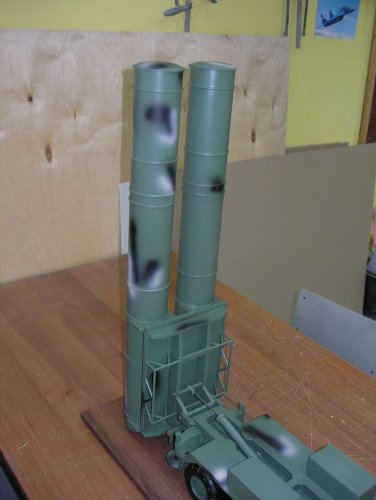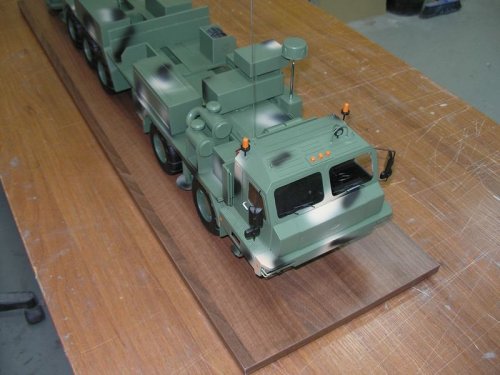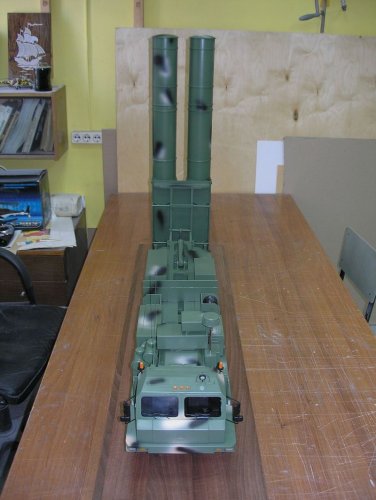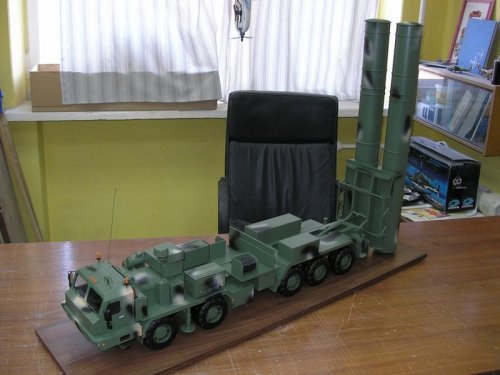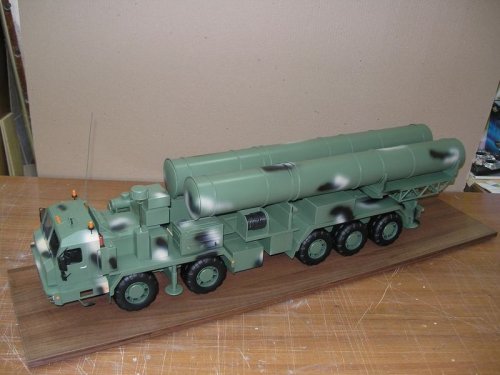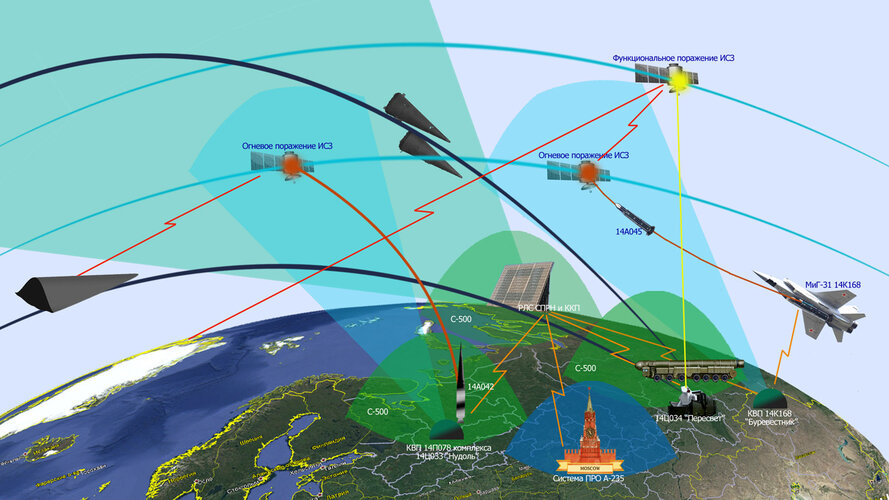You are using an out of date browser. It may not display this or other websites correctly.
You should upgrade or use an alternative browser.
You should upgrade or use an alternative browser.
Almaz-Antey S-500 Prometheus / 55R6M Triumphator-M / System 98Zh6M1
- Thread starter Sferrin
- Start date
- Joined
- 3 June 2011
- Messages
- 18,349
- Reaction score
- 12,269
flateric said:"it's a 10-15 years of imprisonment question"
So take one for the team.
- Joined
- 24 January 2006
- Messages
- 1,322
- Reaction score
- 470
flateric said:"it's a 10-15 years of imprisonment question"
Bah. It's a math question. Give me some time to dig out the right equations and crunch some numbers and I can tell you what kind of reach and range it'll have to have based on what kinds of satellites they want to hit. As long as you aren't trying to hit the really distant targets you comparatively don't need too much performance.
- Joined
- 3 June 2011
- Messages
- 18,349
- Reaction score
- 12,269
SOC said:flateric said:"it's a 10-15 years of imprisonment question"
Bah. It's a math question. Give me some time to dig out the right equations and crunch some numbers and I can tell you what kind of reach and range it'll have to have based on what kinds of satellites they want to hit. As long as you aren't trying to hit the really distant targets you comparatively don't need too much performance.
So the S-500 will be an anti-satellite weapon? Hadn't heard that before this thread.
- Joined
- 24 January 2006
- Messages
- 1,322
- Reaction score
- 470
Yes, that's been stated various times. This is speculation, but logically it's going to have to be a big missile, meaning it will probably not be effective against something like an F-22A. An E-3, maybe, but anything more maneuverable is not going to represent a cooperative target.
- Joined
- 3 June 2011
- Messages
- 18,349
- Reaction score
- 12,269
SOC said:Yes, that's been stated various times. This is speculation, but logically it's going to have to be a big missile, meaning it will probably not be effective against something like an F-22A. An E-3, maybe, but anything more maneuverable is not going to represent a cooperative target.
Is it going to be both anti-aircraft and anti-missile using the same missile or is it a system of missiles like S-300/400?
- Joined
- 24 January 2006
- Messages
- 1,322
- Reaction score
- 470
Depends. You can use the same interceptor for the ABM and ASAT roles. If they're going to give it very long-range S/A capability as well, it'll probably incorporate the 40N6. If I had to guess, I'd say the ABM/ASAT interceptor would likely be related to one of the GAZELLE follow-on projects.
Beyond that, the TEL may be based on the S-400's 5P85T2, but the radar is not going to be able to be a GRAVE STONE modification, not if you're getting ABM and ASAT capability out of the system. Or, they could use a GRAVE STONE for S/A work, and link into the PILL BOX and BMEW systems for the rest of it. THere's also the Mars radar system, looks like a modular FBX-T, that has been mentioned WRT the S-500, that might be what they use for the ABM/ASAT role.
Beyond that, the TEL may be based on the S-400's 5P85T2, but the radar is not going to be able to be a GRAVE STONE modification, not if you're getting ABM and ASAT capability out of the system. Or, they could use a GRAVE STONE for S/A work, and link into the PILL BOX and BMEW systems for the rest of it. THere's also the Mars radar system, looks like a modular FBX-T, that has been mentioned WRT the S-500, that might be what they use for the ABM/ASAT role.
A short write up on S-500 system
S-500 Air & Space Defense System

 austinstalk.blogspot.in
austinstalk.blogspot.in
S-500 Air & Space Defense System
S-500 Air & Space Defense System
S-500 Air & Space Defense System My goal for writing this article is recently there has been lot of press coverage on Russian S-500 Ai...
- Joined
- 3 June 2011
- Messages
- 18,349
- Reaction score
- 12,269
Avimimus said:ABM systems generally are...
Btw. If you need manoeuvrability for your terminal interceptor - why not just go multi-stage?
Just saying the cost equation is already leaning towards the attacker to a disturbing degree. This seems to take it to the next level.
- Joined
- 21 April 2009
- Messages
- 13,761
- Reaction score
- 7,703
And this cost disparity is on a lot of minds. CSBA released a 'Winning the Salvo Wars" papersferrin said:Avimimus said:ABM systems generally are...
Btw. If you need manoeuvrability for your terminal interceptor - why not just go multi-stage?
Just saying the cost equation is already leaning towards the attacker to a disturbing degree. This seems to take it to the next level.
Winning The Salvo Competition: Rebalancing America’s Air And Missile Defenses | CSBA
CSBA is an independent, non-partisan policy research institute established to promote innovative thinking and debate about national security strategy and investment options.
Avimimus said:ABM systems generally are...
Btw. If you need manoeuvrability for your terminal interceptor - why not just go multi-stage?
It would well be multi-stage missile , while doing my own research on the topic they have mentioned seperating warhead for interceptor which in Russian could well mean two stage warhead
sferrin said:What is a, "two-stage warhead"?
What ever they mean by warhead or just Google translation playing trick on Russian term.
It does not make sense to have a single stage missile , even the shirt range missile of A-135 series had 2 stage but that's just my thinking .
- Joined
- 1 April 2006
- Messages
- 11,402
- Reaction score
- 10,340
flateric said:
Hello flateric , is that a toy model or taken from almaz antey office ?
- Joined
- 3 June 2011
- Messages
- 18,349
- Reaction score
- 12,269
SOC said:One of those might be the S-400's TEL for the 40N6. If one is intended to be the S-500 TEL, it's missing the ECS.
I thought you were dead.
- Joined
- 24 January 2006
- Messages
- 1,322
- Reaction score
- 470
sferrin said:I thought you were dead.
Not dead, just gainfully employed! After I got hired I killed off the blog, and avoided a few forums until I figured out what and where I could participate without any sort of conflict of interest or whatnot.
sferrin said:I take it then the 40N6 is not simply the standard sized S-400 "big missile" (48N6) flying a different profile but is instead a much larger missile? Any details you can spill?
Who knows. I still think that 40N6 being a misprint of 48N6 is possible, given that they got a 48N6 to 400 km during S-300PM testing. I've got a photo of an S-500 TEL with an ECS equipped, and given that there are two TELs in the above photos either a) one of them is for the 40N6, or b) they're two possible iterations that led to the S-500 TEL. Or c), they're totally speculative and any resemblance to the S-500 TEL is superficial. Current speculation is that the S-500 missile will draw on the 53T6/45T6, 40N6 on the 9M82.
Good to have you back SOC.
Almaz Chief when asked about S-500 few years back mentioned it was A-135 on wheels
He might be referring to the capability provided by S-500 not the missile , The missile is certainly new from all the sound bytes we heard so far , Check my short write up on S-500

 austinstalk.blogspot.in
austinstalk.blogspot.in
Almaz Chief when asked about S-500 few years back mentioned it was A-135 on wheels
He might be referring to the capability provided by S-500 not the missile , The missile is certainly new from all the sound bytes we heard so far , Check my short write up on S-500
S-500 Air & Space Defense System
S-500 Air & Space Defense System My goal for writing this article is recently there has been lot of press coverage on Russian S-500 Ai...
- Joined
- 21 January 2015
- Messages
- 12,166
- Reaction score
- 16,389
Erdogan Says Russia, Turkey May Discuss Joint Production of S-500 Defence System
ANKARA (Sputnik) - Turkish President Recep Tayyip Erdogan has said that Ankara and Moscow might launch talks on joint production of Russian-made S-500 air defence systems after the S-400 deliveries.
- Joined
- 3 June 2011
- Messages
- 18,349
- Reaction score
- 12,269
Erdogan Says Russia, Turkey May Discuss Joint Production of S-500 Defence System
ANKARA (Sputnik) - Turkish President Recep Tayyip Erdogan has said that Ankara and Moscow might launch talks on joint production of Russian-made S-500 air defence systems after the S-400 deliveries.
Well that will certainly help them get F-35s.
QuadroFX
Russia, Chelyabinsk
so is S-500 the same as SM-3 and THAAD? or will it be a dual role system similar to S-300V? is there any information about what type of missile it will carry?
Deputy minister of defence A. Krivoruchko:
[...]Его основная задача − борьба с боевым оснащением баллистических ракет средней дальности (самостоятельный перехват с дальностью пуска до 3500 км) и межконтинентальных баллистических ракет на конечном участке траектории, а в определённых случаях – и на среднем участке.
use Google translate
tequilashooter
ACCESS: Top Secret
- Joined
- 1 January 2021
- Messages
- 699
- Reaction score
- 895
tequilashooter
ACCESS: Top Secret
- Joined
- 1 January 2021
- Messages
- 699
- Reaction score
- 895
ВКС России получили на оснащение локатор с уникальными характеристиками - Газета.Ru
В конце апреля на вооружение российской армии была принята РЛС «Енисей», рассказал «Газете.Ru» высокопоставленный источник в российском оборонно-промышленном комплексе. Новейшая станция может входить в состав ЗРС С-500, хотя на деле этот локатор — куда более универсальное средство разведки.
New means of reconnaissance: radar station "Yenisei" entered the Russian army
Russian Aerospace Forces received a radar with unique characteristics for equipping air defense systems. At the end of April, the Yenisei radar was adopted by the Russian army, a high-ranking source in the Russian military-industrial complex told Gazeta.Ru. The newest station can be part of the S-500 air defense system, although in reality this locator is a much more universal reconnaissance tool.
The Yenisei radar station, which entered service with the Russian army, is designed for continuous operation for a long time. For example, the S-400 Triumph radar systems (a command post radar system and a multifunctional radar station of an anti-aircraft missile battalion) were not originally intended to function for such a long period, since anti-aircraft battles and battles do not take place for long hours and days.
It is this feature of the Yenisei that makes it possible to receive reconnaissance information for a long time, which is important for the means of conducting radar reconnaissance. At the same time, the operator's error factor is practically excluded - the radar works, as they say, in full automatic mode.
Yenisei is a fully digital locator, its antenna is an active phased array. In addition, the radar is an active-passive device, it can conduct reconnaissance and detect air objects and issue target designations to air defense fire weapons even without broadcasting. That is, "Yenisei" has the functions of conducting electronic intelligence.
In particular, information on targets from the Yenisei is issued to the multifunctional radars of the S-400 and S-500 anti-aircraft missile systems.
This year, a contract will be signed for the supply of the S-500 air defense system, since all the components of the system are already ready. As for the S-400 air defense system, the Yenisei (along with the 96L6 all-altitude detector) is already included in this system.
The Yenisei locator is equipped with remote posts, which allows it to successfully deal with jammers. For example, the success of the US Air Force's actions in many local conflicts was ensured by the fact that practically all air defense systems of Washington's opponents were suppressed by powerful and well-organized interference.
But this does not apply to the Yenisei. The higher the interference intensity, the better the locator ties up target tracks and more accurately gives target designation to air defense fire weapons. So with the adoption of the Yenisei by the Russian Aerospace Forces, the United States, one might say, lost this trump card.
Another feature of the Yenisei radar is that the radar can operate in a sector (recall that most radar reconnaissance equipment operates in a circular view mode). This characteristic allows the radar to successfully issue target designations for ballistic missiles.
By the way, the 96L6 all-altitude detector (VO), usually attached to the S-400 air defense system, cannot work in the sector.
The characteristics of the "Yenisei" interested the leadership of the anti-aircraft missile forces of the Russian Aerospace Forces. So, the radar complex (RLK) 92N6 of the command post of the S-400 anti-aircraft missile system operates "round-the-clock". But it is the continuous and long-term work of the Yenisei in the sector that will sharply increase the effectiveness of anti-aircraft missile defense against ballistic missiles in missile-hazardous areas. Therefore, in the anti-aircraft missile forces at the positions of the command post of the S-400 air defense system, two locators are installed at once - the standard 92N6 S-400 radar and the Yenisei radar.
In addition, the Yenisei “sees” well and accompanies its launched anti-aircraft guided missiles and can very accurately determine whether the target has been hit in the event of a meeting. This feature of the locator really liked the leadership of the anti-aircraft missile forces of the Aerospace Forces. Now, with the help of the Yenisei, they can assess the effectiveness of the anti-aircraft missile units.
"Yenisei" provides the issuance of target designations for hypersonic targets.
And this system has another remarkable feature. For example, the missile of the Iskander-M operational-tactical complex first rises to a great height (about 100 km). Then, on the descending part of the trajectory, it begins to actively maneuver. This makes it almost impossible to intercept it.
Moreover, on the way to the target, the Iskander missile releases carbon threads, which leads to a complete illumination of the enemy radar indicator screens, that is, there is such an abundance of false targets that any effective operation of the enemy's anti-aircraft missile systems on such missiles becomes simply unrealistic. ... In the United States, they have not developed any effective method of confronting the missiles of this complex.
Yenisei, on the other hand, “sees” such targets, can steadily accompany them and issue precise target designations on them.
In addition, Yenisei is able to effectively combat atmospheric phenomena, the so-called "angels". They arise mainly over water surfaces and cause a strong illumination of the indicator screens (in the form of a large number of false targets) of both detection radars and missile guidance stations. In particular, the Chinese came face to face with them after purchasing the S-400 air defense system and placing their starting positions near water surfaces. Domestic experts have made effective protection (by various kinds of algorithmic tricks) and from "angels", including on the Yenisei radar.
Also, the Yenisei is equipped with built-in state identification means, both domestic (the Guardian system) and NATO MK-12 (the latter may be of interest to foreign customers). In addition, the locator also has a secondary channel for operation in the EU ATC (unified air traffic control system) in the range of 1030-1090 MHz. This allows the Yenisei to have complete information about the civilian aircraft currently in the air.
The Yenisei radar is highly maneuverable. The coagulation / deployment time does not exceed 5 minutes.
To increase mobility, outriggers (outriggers), which, for example, have, for example, VVO 96L6, were removed from the Yenisei. Mechanical "paws" for leveling at this radar remained, but they are already being put forward in a rut, without removal.
Yenisei detects airborne objects at altitudes of more than 100 km (on the border of space and air space), at ranges over 600 km, steadily accompanies them and is a universal and multifunctional tool for detecting a variety of airborne objects and issuing precise target designations to fire weapons air defense.
The name "Yenisei" has already been carried in the past by a mobile two-coordinate VHF radar station of the P-12 radar. This locator entered service with the radio engineering troops (RTV Air Defense Forces) in 1956 and for many decades served in the field of protecting the airspace of the USSR.
tequilashooter
ACCESS: Top Secret
- Joined
- 1 January 2021
- Messages
- 699
- Reaction score
- 895
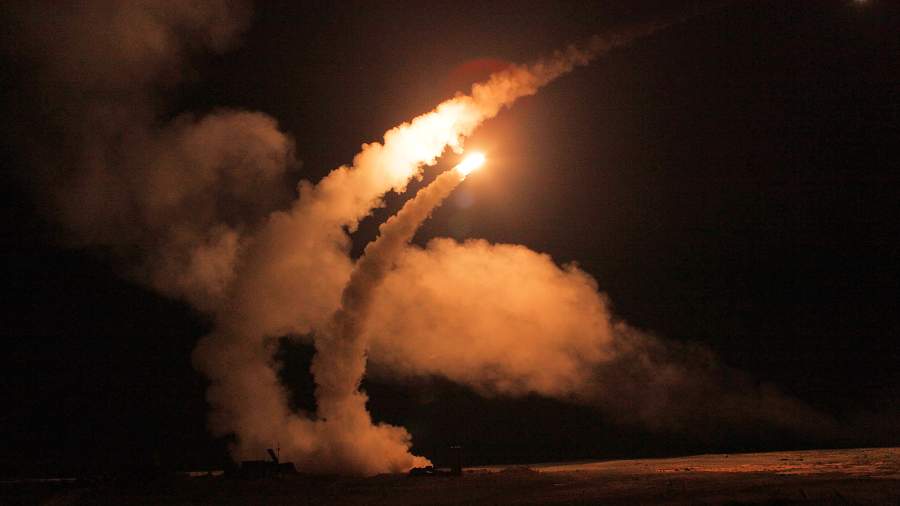
«Прометею» добавят огня: С-500 получит новые ракеты-перехватчики
Зенитная система сможет сбивать даже гиперзвуковые летательные аппараты
Fire will be added to Prometheus: S-500 will receive new interceptor missiles
The anti-aircraft system will be able to shoot down even hypersonic aircraft
Sources in the military department told Izvestia that the latest anti-missile missile for the S-500 is currently in a high degree of readiness. The ammunition was successfully tested at the Sary-Shagan training ground in Kazakhstan.
After a series of launches, he confirmed the inherent characteristics, and the combat crews successfully completed the task, hitting a conditional target with a given accuracy . True, the interlocutor of the publication refused to name the index, as well as the characteristics of the novelty.
According to him, in addition to "Prometheus", the same product will be used in the updated stationary anti-missile defense (ABM) system in Moscow.
tequilashooter
ACCESS: Top Secret
- Joined
- 1 January 2021
- Messages
- 699
- Reaction score
- 895
Dont think it has one yet but we know its name will start with the letter G. https://en.wikipedia.org/wiki/List_of_NATO_reporting_names_for_surface-to-air_missiles. I am going with Glowfly https://scrabble.merriam.com/words/start-with/gI'd like to know what its NATO designation is?
Dont think it has one yet but we know its name will start with the letter G. https://en.wikipedia.org/wiki/List_of_NATO_reporting_names_for_surface-to-air_missiles. I am going with Glowfly https://scrabble.merriam.com/words/start-with/gI'd like to know what its NATO designation is?
It's likely it would be the SA-26 and while "Glowfly" is one choice another would be "Grifter" (A subtle swipe at Trump) or perhaps "Goblin" (A swipe at Putin).
tequilashooter
ACCESS: Top Secret
- Joined
- 1 January 2021
- Messages
- 699
- Reaction score
- 895
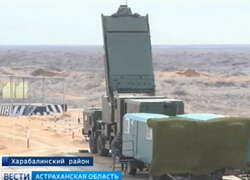
Новая РЛС «Енисей» для комплексов С-500 «Прометей» принята на вооружение
Новейшая РЛС «Енисей» — современное и универсальное средство воздушной разведки, способное отслеживать даже гиперзвуковые цели — принята на вооружение. Об этом сообщил еженедельник «Звезда».Одной из ключевых особенностей «Енисея», в отличие от штатной РЛС комплекса С-400 «Триумф», является...
The new Yenisei radar for the S-500 Prometheus air defense systems has been put into service.
The latest Yenisei radar, a modern and versatile aerial reconnaissance vehicle capable of tracking even hypersonic targets, has been adopted. This was reported by the weekly newspaper "Zvezda".
One of the key features of the Yenisei, in contrast to the standard radar of the S-400 Triumph complex, is the ability to work continuously for a long time and in automatic mode. Therefore, now the Yenisei radar has also been used as part of the S-400, along with the 96L6 all-altitude detector, in order to increase the efficiency of the complex.
The latest radar is able to detect air objects, both "own" and "foreign", at an altitude of more than 100 kilometers and at a distance of more than 600 kilometers, this also applies to hypersonic missiles. At the same time, the work is not carried out by sector, but by a round-robin review. The jammers will not be able to confuse the Yenisei ,their impact is blocked by remote posts. It takes only five minutes to bring the radar to full combat readiness.
Most of the characteristics of this radar station, which in the future should become the "eyes" of the promising S-500 Prometheus air defense system, still remains classified. Suffice it to say that the only time it appeared in public was in April 2018 during an exercise in the Astrakhan region, and since then there has been no news about the development.
tequilashooter
ACCESS: Top Secret
- Joined
- 1 January 2021
- Messages
- 699
- Reaction score
- 895
Didn't know where to put this news but because it mentions the air defense company I will put it here.
https://ruselectronics.ru/news/2288...h-oborudovanie-dlya-izmeritelnogo-kompleksa-/
Roselectronica Holding Rostec State Corporation has supplied almaz-Antey vs. Almaz-Antey Concern with a super-powerful microwave module for use as part of a multifunctional measuring complex. The equipment is used to measure basic electrodynamic characteristics, in particular to determine the effective scattering area of air and ground equipment.
The range microwave module is designed to form probing pulse signals of a given amplitude and a certain frequency of follow. The device is used as part of a measuring complex, which works on the principle of radar. The manufactured module has no analogues in the power of the microwave signal and provides an increased working radius of the measuring complex. The device also has control software, frequency meter and self-made power meter. The equipment has a high efficiency, compactness and usability.
The product was designed and manufactured by the Ferrit-Domen Research Institute (part of Roselectronics) according to the technical requirements of the customer - AO CNIRTI by A.I. Berg (part of the Almaz-Antey Concern).
"Engineers of the Ferrit-Domen Research Institute managed to create an unparalleled microwave device in record time. As a result of the project, our company has expanded its competence in the development and production of civilian electronic products with the acceptance of OTC. We expect that the successful experience of cooperation with one of the leading enterprises of Almaz-Antey Concern will allow the institute to become a reliable supplier of microwave modules for measuring equipment. Currently, work is already underway to conclude a new contract for the supply of a different type of microwave module next year," said Aikaz Ohanesian, Deputy Director General for Civil Products at the Ferrit-Domen Research Institute.
https://ruselectronics.ru/news/2288...h-oborudovanie-dlya-izmeritelnogo-kompleksa-/
Roselectronica Holding Rostec State Corporation has supplied almaz-Antey vs. Almaz-Antey Concern with a super-powerful microwave module for use as part of a multifunctional measuring complex. The equipment is used to measure basic electrodynamic characteristics, in particular to determine the effective scattering area of air and ground equipment.
The range microwave module is designed to form probing pulse signals of a given amplitude and a certain frequency of follow. The device is used as part of a measuring complex, which works on the principle of radar. The manufactured module has no analogues in the power of the microwave signal and provides an increased working radius of the measuring complex. The device also has control software, frequency meter and self-made power meter. The equipment has a high efficiency, compactness and usability.
The product was designed and manufactured by the Ferrit-Domen Research Institute (part of Roselectronics) according to the technical requirements of the customer - AO CNIRTI by A.I. Berg (part of the Almaz-Antey Concern).
"Engineers of the Ferrit-Domen Research Institute managed to create an unparalleled microwave device in record time. As a result of the project, our company has expanded its competence in the development and production of civilian electronic products with the acceptance of OTC. We expect that the successful experience of cooperation with one of the leading enterprises of Almaz-Antey Concern will allow the institute to become a reliable supplier of microwave modules for measuring equipment. Currently, work is already underway to conclude a new contract for the supply of a different type of microwave module next year," said Aikaz Ohanesian, Deputy Director General for Civil Products at the Ferrit-Domen Research Institute.
QuadroFX
Russia, Chelyabinsk
This SAM is really fast!
Similar threads
-
-
-
S-4 and S-45 IRBM projects (France, Cold War)
- Started by Grey Havoc
- Replies: 6
-
Excalibur Almaz commercial space station
- Started by FutureSpaceTourist
- Replies: 4
-
3R41 Volna Design Question.
- Started by stealthflanker
- Replies: 2

